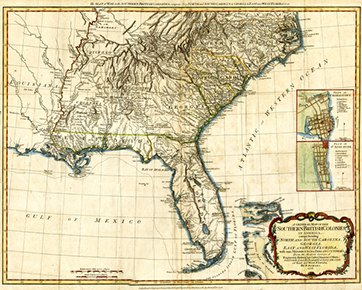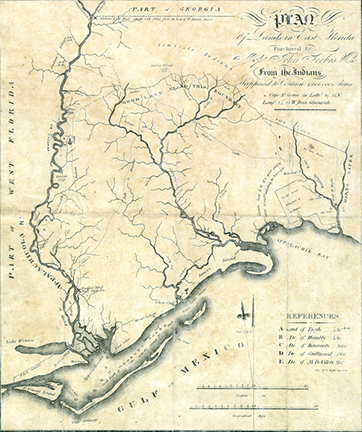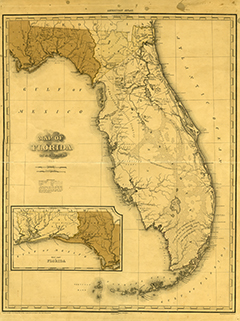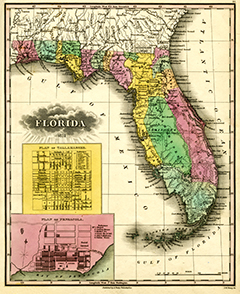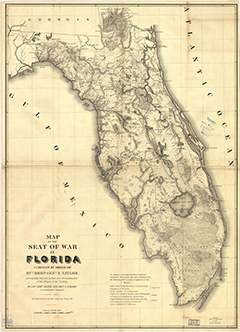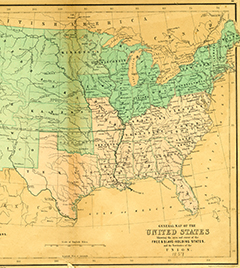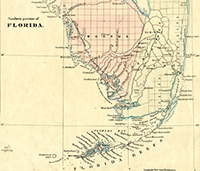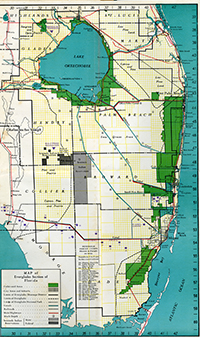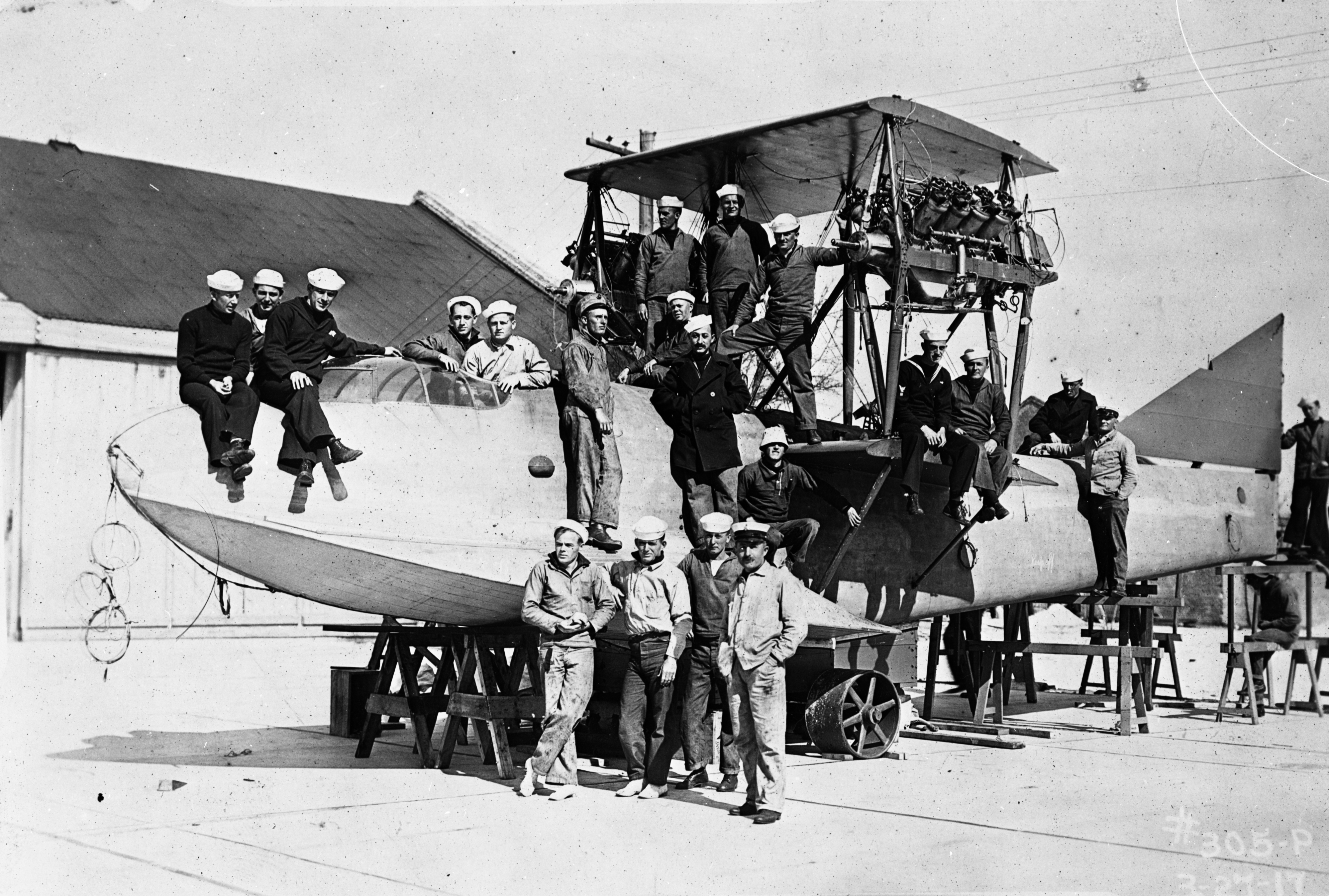The Florida Seminoles
Lesson Plans
The Causes and Effects of the Seminole Wars
SS.4.A.3.10: Identify the causes and effects of the Seminole Wars.
Resources:
(Slide One)
This lesson plan uses maps to teach students about the causes and effects of the Seminole Wars.
(Slide Two)
The resources for this lesson are: a 1776 map of the southern British colonies; (Slide Three) an 1817 map of the Forbes Purchase; (Slide Four) an 1823 map of the Florida territory; (Slide Five) an 1831 map of the Florida territory; (Slide Six) an 1839 map of villages, battles, and forts during the Second Seminole War; (Slide Seven) an 1857 map of the eastern United States; (Slide Eight) an 1873 map of south Florida; (Slide Nine) and a 1940 map of south Florida.
(Slide Ten)
The Seminoles migrated into Florida in the 1700s. They lived in the northern and central parts of the state.
(Slide Eleven)
There were three main causes of the Seminole Wars: disputes over land, trade, and slavery.
The U.S. wanted the land on which the Seminoles lived, but the Seminoles did not want to leave.
The U.S. wanted the Seminoles to trade only with the Americans and not with other countries.
Escaped slaves fled to Florida and joined the Seminoles. The U.S. wanted the Seminoles to return slaves to their owners.
In the tense climate created by these issues, several events led to the outbreak of wars between the Seminoles and the U.S.
(Slide Twelve)
For example, in 1816, American soldiers destroyed a fort on the Apalachicola River, known as the “Negro Fort.”
Inside the fort were blacks and Native Americans who wanted to stop Americans from taking their land. Many of these people died when the Americans destroyed the fort.
(Slide Thirteen)
In 1817-1818, conflict broke out along the Florida-Georgia border. General Andrew Jackson invaded Spanish Florida to put down the uprising. His army destroyed Seminole and black villages across northern Florida. Jackson also attacked Pensacola before he left Florida. This conflict is known as the First Seminole War.
(Slide Fourteen)
Spain sold Florida to the U.S. in 1821 for $5 million. At the time, the U.S. wanted to sign an agreement with the Seminoles to take their land in North Florida.
This treaty, called the Treaty of Camp Moultrie, forced the Seminoles to move to a reservation in Central Florida. The reservation is indicated on this map by the large green shape in Central Florida. Many Seminoles opposed the treaty.
(Slide Fifteen)
In 1830, Congress passed the Indian Removal Act. This Act required Native Americans living in the southeast to move to the Indian Territory west of the Mississippi River.
The Indian Removal Act led to the Treaty of Paynes’s Landing between the U.S. and the Seminoles. The treaty required that the Seminoles send their leaders to the Indian Territory to examine the land assigned to them.
During their trip West, U.S. officials forced the Seminoles to sign an agreement called the Treaty of Fort Gibson. This treaty required the Seminoles to leave Florida by 1835.
(Slide Sixteen)
Most Seminoles opposed these treaties and fought back against the U.S. The Second Seminole War started in December 1835 when warriors attacked U.S. troops on the road from Fort Brooke (Tampa) to Fort King (Ocala). This battle, known as Dade’s Battle, was the first in a war that lasted seven years and cost the U.S. government an estimated $40 million.
(Slide Seventeen)
During the Second Seminole War, the U.S. Army captured Seminoles and sent them to the Indian Territory.
The Seminoles’ Trail of Tears went from Tampa (Fort Brooke) to New Orleans and then up the Mississippi River to the Indian Territory. By the end of the Seminole Wars, more than 4,000 Seminoles and Black Seminoles were deported to the Indian Territory.
(Slide Eighteen)
When the Third Seminole War ended in 1858, less than 200 Seminoles remained in Florida. They had to adjust their way of life to survive in South Florida.
By the late 1800s, American settlers occupied much of the land that used to belong to the Seminoles.
(Slide Nineteen)
Settlers built towns and cities, roads and bridges. They also started farms. The impact of settlers changed the environment of South Florida. Farmers drained wetlands and polluted the environment with pesticides. Cities and towns took over the forests and swamps.
If you look at current maps of Florida, you’ll see that many place names come from the Seminole Wars.
For example, Tallahassee, Okeechobee, Loxahatchee, and Caloosahatchee are all Muscogee-language terms, the language spoken by Seminoles.
Cities like Gainesville and Jacksonville are named for Seminole War generals. Cities like Fort Lauderdale, Fort Myers, and Fort Pierce were all founded during the Seminole Wars.
The Florida of today was created by the causes and effects of the Seminole Wars.

 Listen: The Folk Program
Listen: The Folk Program